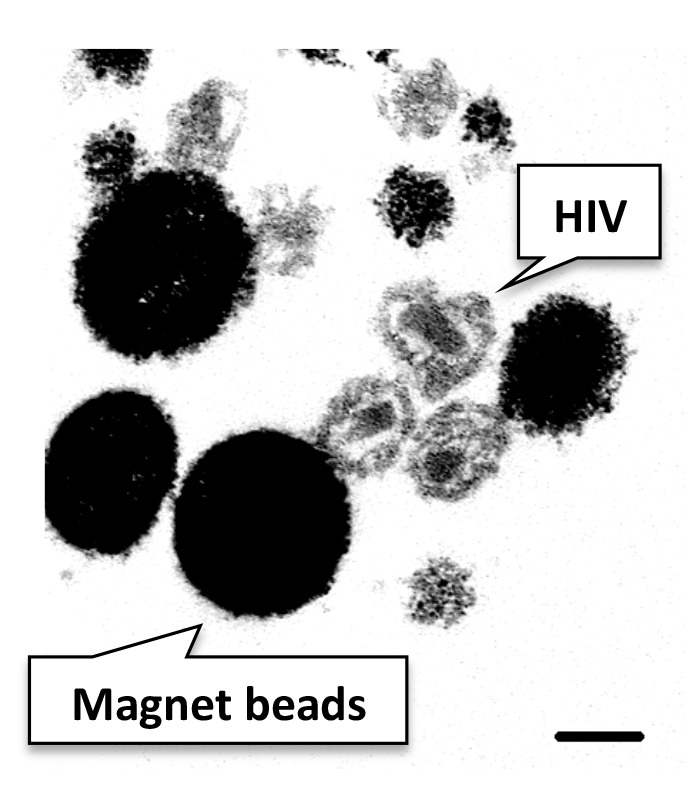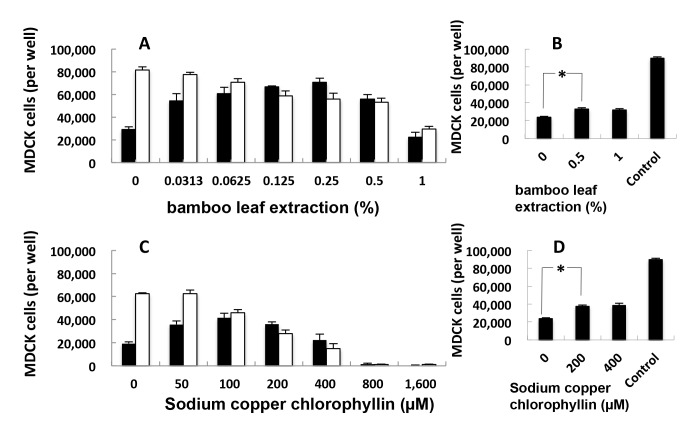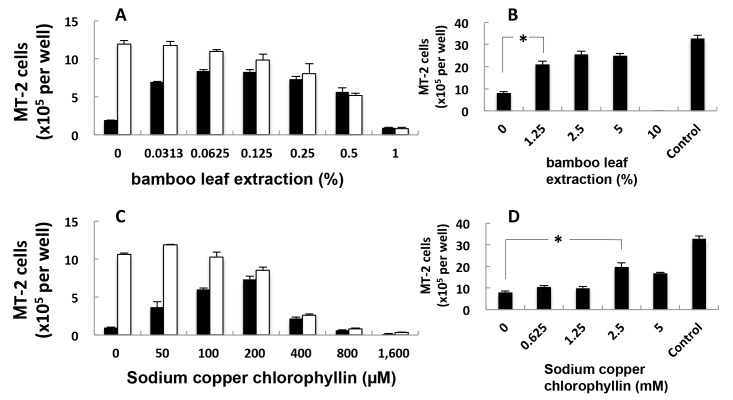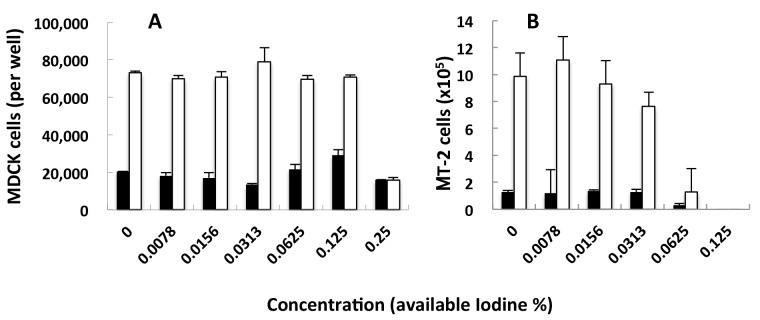Abstract
Background
Although the link between oral and oropharyngeal health status and susceptibility to infection has long been recognized, there is a limit to the selection of antiseptics for oral care.
Methods
Madin-Darby canine kidney (MDCK) cells were exposed to influenza virus and cultured in the presence or absence of test reagents: bamboo leaf extract solution and sodium copper chrolophyllin. MDCK cells were pre-incubated with the reagents to assess the inhibitory activity at adsorption (viral attachment). Similarly, anti-HIV activity and the inhibitory mechanism at adsorption were assessed by MT-2 cell culture system. Mixture of HIV and bamboo leaf extract solution was fixed and examined by transmission electron microscopy.
Results
The 50% inhibitory concentration (IC50) of bamboo leaf extract solution against influenza virus and the 50% cytotoxic concentration (CC50) in MDCK cells of the solution lay between 0.0313–0.0625% and 0.5–1.0%. The solution inhibited the influenza virus adsorption at the concentration of 0.5% (P < 0.05). The values of IC50 and CC50 of sodium copper chlorophyllin lay between 50–100 µM and 200–400 µM, respectively. This inhibited the virus adsorption at 200 µM (P < 0.05). The bamboo leaf extract solution showed values of IC50 against HIV and CC50 in MT-2 cells at around 0.0313% and between 0.25–0.5%, respectively. This solution inhibited HIV adsorption at 1.25% (P < 0.05). The IC50 and CC50 of sodium copper chlorophyllin lay between 50–100 µM and 200–400 µM, respectively. Sodium copper chlorophyllin inhibited HIV adsorption at 2.5 mM (P < 0.05). HIV particles survived after the exposure to 0.5% bamboo leaf extract solution.
Conclusion
Sodium copper chlorophyllin exerted antiviral activities against influenza virus and HIV as the major ingredient of bamboo leaf extract solution by blocking adsorption. This mechanism of action is different completely from the one of povidone-iodine.
Keywords: adsorption, bamboo leaf extract solution, HIV, influenza, human, sodium copper chlorophyllin
The accumulation of dental plaque and colonization of oral surfaces with respiratory pathogens serves as a reservoir for recurrent lower respiratory tract infections.1–5 Indeed, professional oral health care by dental hygienists is effective in preventing respiratory infections in elderly persons requiring nursing care.6–9 Although the linkage between oral and oropharyngeal health status and susceptibility to infection has long been recognized, there is a limit to the selection of antiseptics for oral care.10, 11
Povidone-iodine is one such antiseptic and considered to have the broadest spectrum of antimicrobial action compared with other common antiseptics.12, 13 Oxidative potency of povidone-iodine enables destruction of various structures and enzymes of microbes and viruses.14 However, the antiseptic has a limitation leading to the possible cytotoxic potential to mammalian cells through this mechanism of pathogen killing.15–17 Therefore, further exploration is required for the development of new materials that have different anti-pathogenic mechanisms.
Influenza viruses cause a viral respiratory infection particularly among high-risk individuals, such as children, aged persons, and patients with chronic disorders. Some reports indicate that the unclean condition in the oral cavity promotes influenza infection,18 and good oral hygiene minimizes the severity of respiratory illness.3, 19 Human immunodeficiency virus (HIV) infected approximately 34 million individuals causing acquired immune deficiency syndrome (AIDS) worldwide. One investigation found that 76.7% of HIV-infected individuals showed oral symptoms among tested AIDS cases.20 Among these HIV-infected individuals, gum bleeding is observed frequently due to corruption of mucous membrane of the oral cavity after the progress of caries.21–23 Such bleeding from the oral cavity may increase the possibility of HIV transmission to partners. Therefore, it is indispensable for such individuals to efficiently improve their own oral care with potent antimicrobial activity for prevention of infection and disease development.
In the present study, antiviral activities of a plant extract and its ingredient against influenza virus and HIV were assessed for antiseptic use.
MATERIALS AND METHODS
Influenza virus cytopathic assay
Madin-Darby canine kidney (MDCK) cells were seeded (30,000 per well) in 96-plate and incubated for approximately 24 hours. Then, the semi-confluent cells were washed twice with phosphate-buffered saline, exposed to influenza virus [A/Tottori/ST215/2009(H1N1)] at a dose of 108 copies per well and cultured in the presence or absence of various concentrations of test reagents: bamboo leaf extract solution (kindly provided by Environmental Plant Industry, Yonago, Japan), sodium copper chlorophyllin (Wako, Osaka, Japan), and povidone-iodine (‘Isodine gargle’, Meiji, Tokyo, Japan). The culture was maintained in Dulbecco’s modified eagle medium (D-MEM) supplemented with 10 µg/mL trypsin (Beckton Dickinson, Tokyo, Japan), 0.2% heat-inactivated bovine serum albumin, 200 units/mL penicillin G, and 100 µg/mL streptomycin at 34 ℃ under a 5% CO2/95% air atmosphere for three days. Control cells were not exposed to the virus. The total viable cells were counted by a sensitive colorimetric assay (Cell Counting Kit-8, Wako, Osaka) on day 3.
The semi-confluent MDCK cells were pre-incubated with the bamboo leaf extract solution (0.5 and 1%), sodium copper-chlorophyllin (200 and 400 µM) or test reagent-free culture medium for 10 min to assess the inhibitory activity at adsorption (viral attachment). The pre-incubated cells were washed extensively to be able to ignore antiviral activity of the remaining test reagents in the culture medium, and then exposed to the influenza virus (5x107 copies per well). In addition to these pre-incubated cells, control wells were prepared to evaluate growth of the cells in a virus-free condition. Then, virus-exposed and mock-exposed cells were cultured in the absence of test reagents for three days. The total viable cells were counted on day 3.
HIV cytopathic assay
MT-2 cells (105 cell per mL) were exposed to of HIV-1LAI at 1.3x10-4 median tissue culture infectious dose (TCID50) per cell, and cultured in the presence or absence of various concentrations of bamboo leaf extract solution, sodium copper chlorophyllin, and povidone-iodine on day 0. The culture was maintained in RPMI-1640 medium supplemented with 10% heat-inactivated fetal bovine serum, 200 units/mL penicillin G, and 100 µg/mL streptomycin at 37 ℃ under a 5% CO2/95% air atmosphere for four days. Control cells were not exposed to the virus. The total viable cells were counted by trypan blue dye exclusion method on day 4.
MT-2 cells were pre-incubated to the bamboo leaf extract solution (up to 10%), sodium copper chlorophyllin (up to 5 mM) or test reagent-free culture medium for 10 min to assess the inhibitory activity at adsorption. The pre-incubated cells were washed extensively to be able to eliminate antiviral activity of test reagents remaining in the culture medium, and then they were exposed to HIV-1LAI (1.3x10-4 TCID50 per cell). In addition to these pre-incubated cells, control wells were prepared to evaluate growth of the cells in a virus-free condition. Then, virus-exposed and mock-exposed cells were cultured in the absence of test reagents for three days. The total viable cells were counted on day 3.
Transmission electron microscopy
The HIV-1LAI (50 µL, 4,000 TCID50 per mL) was subjected to Viro-adembeads (ADEMTEC, Pessac, France) according to manufacturer’s instruction. The HIV-1LAI captured with Viro-adembeads was incubated with an equal volume of bamboo leaf extract solution at an ambient temperature for 5–10 min. The mixture was then fixed with 2.5% glutaraldehyde at 4 ℃ for more than one hour, washed twice with 70% ethanol and re-suspended with phosphate buffered saline (100 µL). The fixed virus particles were postfixed in 1% osmium tetroxide, and stained with 1% uranyl acetate for 1h. They were then dehydrated in graded ethanol, and embedded in Epon. Thin sections were stained with uranyl acetate and lead citrate and examined with a JEM-1400 transmission electron microscope (JEOL, Tokyo, Japan).
Statistical analysis
Statistical analyses were performed using the JMP 9 software (SAS Institute, Cary, NC). The increase in the total viable cells was evaluated by Dunett’s test, and P < 0.05 was regarded as statistically significant.
RESULTS
Anti-influenza virus activity of bamboo leaf extract solution and sodium copper chlorophyllin and its inhibitory mechanism
Original bamboo leaf extract solution containing 3.3–3.9 mM sodium copper chlorophyllin was defined as 100% concentration in the present experiment. The 50% inhibitory concentration (IC50) of bamboo leaf extract solution lay between 0.0313 and 0.0625%. The 50% cytotoxic concentration (CC50) of the solution lay between 0.5 and 1% (Fig. 1A). The solution exhibited pretreatment effect and inhibited the influenza virus adsorption at a concentration of 0.5% (P < 0.05) (Fig. 1B). The values of IC50 and CC50 of sodium copper chlorophyllin lay between 50–100 µM and 200–400 µM, respectively (Fig. 1C). Sodium copper chlorophyllin also exhibited virus adsorption at 200 µM (P < 0.05) (Fig. 1D).
Fig. 1.
Inhibition of the cytopathic effect of influenza virus by bamboo leaf extract solution and sodium copper chlorophyllin. A: MDCK cells were exposed to influenza virus, and cultured in the presence or absence of various concentrations of bamboo leaf extract solution (solid column). Control cells were not exposed to the virus (open column). Data were expressed as mean ± standard error (n = 4). B: MDCK cells were pre-incubated to the bamboo leaf extract solution or medium and then exposed to the influenza virus after extensive washing. Cell culture was carried out in the absence of test reagent. The total viable cells were counted on day 3. C: The viable MDCK cells exposed to influenza virus were cultured in the presence or absence of the sodium copper chlorophyllin. D: Pre-incubated MDCK cells to the sodium copper chlorophyllin or medium were exposed to the influenza virus after extensive washing. Cell culture was carried out in the absence of test reagent. *P < 0.05 by Dunnett’s test. MDCK, Madin-Darby canine kidney.
Anti-HIV activity of bamboo leaf extract solution and sodium copper chlorophyllin and its inhibitory mechanism
The bamboo leaf extract solution showed values of IC50 and CC50 at around 0.0313% and between 0.25–0.5%, respectively (Fig. 2A). This solution exhibited pretreatment effect on the inhibition of HIV adsorption at the concentration of 1.25% (P < 0.05) (Fig. 2B). As with the anti-influenza virus activity, the IC50 and CC50 of sodium copper chlorophyllin lay between 50–100 µM and 200–400 µM, respectively (Fig. 2C). Sodium copper chlorophyllin also exhibited pretreatment effect and inhibited HIV adsorption at 2.5 mM (P < 0.05) (Fig. 2D).
Fig. 2.
Inhibition of the cytopathic effect of HIV by bamboo leaf extract solution and sodium copper chlorophyllin. The entire procedure was carried out similarly to the inhibition assay of cytopathic effect of influenza virus except susceptible cells and viral inoculum: MT-2 cells and HIV. *P < 0.05 by Dunnett’s test. MDCK, Madin-Darby canine kidney; HIV, Human immunodeficiency virus.
Anti-influenza virus and anti-HIV activities of povidone-iodine ‘Isodine gargle’
No antiviral activity can be observed against influenza virus and HIV although the povidone-iodine concentration increased to a level close to cytotoxic concentration: 0.125–0.25% of available iodine in MDCK cell culture (Fig. 3A) and 0.0313–0.0625% in MT-2 cells (Fig. 3B).
Fig. 3.
Inhibition of the cytopathic effect of influenza virus and HIV. A: MDCK cells were exposed to influenza virus and cultured in the presence or absence of povidone-iodine (solid column). Control cells were not exposed to the virus (open column). The reagent concentration was increased up to the cytotoxic level (0.25%). B: Similarly, MT-2 cells were exposed to HIV and cultured. There was no viable cell at 0.125% on day 3. MDCK, Madin-Darby canine kidney; HIV, Human immunodeficiency virus.
Morphology of HIV particles after exposure to bamboo leaf extract solution
Stability of HIV particles was analyzed in the concentration with potent antiviral activity in the HIV culture. Intact HIV particles could be observed even in the presence of 0.5% bamboo leaf extract solution (Fig. 4). This concentration is sufficient to exhibit an anti-HIV activity in culture (0.5%, in Fig. 2A), and corresponds to 16-fold of IC50 and around CC50.
Fig. 4.

Intact HIV particles after exposure to higher concentration of bamboo leaf extract. Typical HIV particles approximately 120 nm in diameter with a conical capsid can be seen even after incubation with 0.5% bamboo leaf extract solution for more than five minutes. The diameter of magnet beads ranges from 100–500 nm according to manufacturer (Ademteck). Bar = 100 nm. MDCK, Madin-Darby canine kidney; HIV, Human immunodeficiency virus.
DISCUSSION
Antiviral activity of bamboo leaf extract solution was recognized as an agent that fights against the influenza virus and HIV, and was exhibited presumably by inhibition of viral adsorption to cells as reported for other natural ingredients, such as black tea, coffee, Morinda citrifolia leaves, manuka honey and bananas.24–28 One ingredient, sodium copper chrolophyllin, also had antiviral activity against influenza and HIV through the same antiviral mechanism of the extract solution. The activity of this extract solution may be due to this ingredient. The IC50 of the extract solution lay between 0.0313 and 0.0625% and must contain 116–230 µM sodium copper chlorophyllin. Similarly, the IC50 of the compound, sodium copper chrolophyllin, lay between 50–100 µM. These two IC50 values of sodium copper chlorophyllin as ingredients and compound were almost in the same concentration range. These results suggested sodium copper chlorophyllin exerted antiviral activities against influenza and HIV as the major ingredient of bamboo leaf extract solution.
As described above, the extract solution and sodium copper chlorophyllin exerted antiviral activities by inhibiting the virus-to-cell interaction on the cell surface, as this inhibitory mechanism has been estimated as non-specific interaction against several different microbes. 29–32 The mechanism of action must be different from the one of povidone–iodine.12, 33 The extract solution and sodium copper chrolophyllin kept antiviral activities for the entire culture period, but povidone-iodine did not inhibit cytopathic effect even at a subtoxic concentration. Povidone-iodine must exert antiviral activity for short instances such as one minute incubation, and give irreversible damage to viral particles as summarized before.12 This difference was also supported by the fact that HIV particles were not destroyed after 5–10 min exposure to subtoxic concentration of bamboo leaf extract solution, and could be recognized by electron microscopy. However, additional morphological examination has to be carried out also in the presence of povidone iodine for further discussion of the difference between antiviral mechanisms of the bamboo leaf extract and povidone iodine.
In the current study, sodium copper chlorophyllin exerted antiviral activities against influenza virus and HIV as the major ingredient of bamboo leaf extract solution by blocking viral-cell interaction (adsorption step) and interfering with the internalization of viruses and resultant replication. This mechanism of action is completely different from the one occurring with povidone-iodine.
Acknowledgments
Ackonwlegments: The authors wish to thank the Environmental Plant Industry for providing bamboo leaf extract.
The authors declare no conflict of interest.
REFERENCES
- 1. El-Solh AA. Association between pneumonia and oral care in nursing home residents. Lung. 2011; 189: 173-80. . [DOI] [PubMed] [Google Scholar]
- 2. Scannapieco FA, Bush RB, Paju S. Associations between periodontal disease and risk for nosocomial bacterial pneumonia and chronic obstructive pulmonary disease. A systematic review. Annals of periodontology / the American Academy of Periodontology. 2003; 8: 54-69. . [DOI] [PubMed] [Google Scholar]
- 3. Azarpazhooh A, Leake JL. Systematic review of the association between respiratory diseases and oral health. Journal of periodontology. 2006; 77: 1465-82. . [DOI] [PubMed] [Google Scholar]
- 4. Pace CC, McCullough GH. The association between oral microorgansims and aspiration pneumonia in the institutionalized elderly: review and recommendations. Dysphagia. 2010; 25: 307-22. . [DOI] [PubMed] [Google Scholar]
- 5. Okuda K, Kato T, Ishihara K. Involvement of periodontopathic biofilm in vascular diseases. Oral diseases. 2004; 10: 5-12. . [DOI] [PubMed] [Google Scholar]
- 6. Adachi M, Ishihara K, Abe S, Okuda K. Professional oral health care by dental hygienists reduced respiratory infections in elderly persons requiring nursing care. International journal of dental hygiene. 2007; 5: 69-74. . [DOI] [PubMed] [Google Scholar]
- 7. Abe S, Ishihara K, Okuda K. Prevalence of potential respiratory pathogens in the mouths of elderly patients and effects of professional oral care. Archives of gerontology and geriatrics. 2001; 32: 45-55. . [DOI] [PubMed] [Google Scholar]
- 8. Kohno S, Imamura Y, Shindo Y, Seki M, Ishida T, Teramoto S, et al. Clinical practice guidelines for nursing- and healthcare-associated pneumonia (NHCAP) [complete translation]. Respiratory investigation. 2013; 51: 103-26. . [DOI] [PubMed] [Google Scholar]
- 9. Teramoto S, Yoshida K, Hizawa N. Update on the pathogenesis and management of pneumonia in the elderly-roles of aspiration pneumonia. Respiratory investigation. 2015; 53: 178-84. . [DOI] [PubMed] [Google Scholar]
- 10. Brown AR, Papasian CJ, Shultz P, Theisen FC, Shultz RE. Bacteremia and intraoral suture removal: can an antimicrobial rinse help?. Journal of the American Dental Association (1939). 1998; 129: 1455-61. . [DOI] [PubMed] [Google Scholar]
- 11. Lockhart PB. An analysis of bacteremias during dental extractions. A double-blind, placebo-controlled study of chlorhexidine. Archives of internal medicine. 1996; 156: 513-20. . [PubMed] [Google Scholar]
- 12. Kanagalingam J, Feliciano R, Hah JH, Labib H, Le TA, Lin JC. Practical use of povidone-iodine antiseptic in the maintenance of oral health and in the prevention and treatment of common oropharyngeal infections. International journal of clinical practice. 2015; 69: 1247-56. . [DOI] [PMC free article] [PubMed] [Google Scholar]
- 13. Kunisada T, Yamada K, Oda S, Hara O. Investigation on the efficacy of povidone-iodine against antiseptic-resistant species. Dermatology (Basel, Switzerland). 1997; 195 Suppl 2: 14-8. . [DOI] [PubMed] [Google Scholar]
- 14. Schreier H, Erdos G, Reimer K, Konig B, Konig W, Fleischer W. Molecular effects of povidone-iodine on relevant microorganisms: an electron-microscopic and biochemical study. Dermatology (Basel, Switzerland). 1997; 195 Suppl 2: 111-6. . [DOI] [PubMed] [Google Scholar]
- 15. Sauerbrei A, Wutzler P. Virucidal efficacy of povidone-iodine-containing disinfectants. Letters in applied microbiology. 2010; 51: 158-63. . [DOI] [PubMed] [Google Scholar]
- 16. Liu FC, Liou JT, Hui YL, Hsu JC, Yang CY, Yu HP, et al. Chemical burn caused by povidone-iodine alcohol solution--a case report. Acta anaesthesiologica Sinica. 2003; 41: 93-6. . [PubMed] [Google Scholar]
- 17. Kara A, Tezer H, Devrim I, Cengiz AB, Secmeer G. Chemical burn: a risk with outdated povidone iodine. Pediatric dermatology. 2007; 24: 449-50. . [DOI] [PubMed] [Google Scholar]
- 18. Abe S, Ishihara K, Adachi M, Sasaki H, Tanaka K, Okuda K. Professional oral care reduces influenza infection in elderly. Archives of gerontology and geriatrics. 2006; 43: 157-64. . [DOI] [PubMed] [Google Scholar]
- 19. Ishikawa A, Yoneyama T, Hirota K, Miyake Y, Miyatake K. Professional oral health care reduces the number of oropharyngeal bacteria. Journal of dental research. 2008; 87: 594-8. . [DOI] [PubMed] [Google Scholar]
- 20. Bodhade AS, Ganvir SM, Hazarey VK. Oral manifestations of HIV infection and their correlation with CD4 count. Journal of oral science. 2011; 53: 203-11. . [DOI] [PubMed] [Google Scholar]
- 21. Gillespie GM, Marino R. Oral manifestations of HIV infection: a Panamerican perspective. Journal of oral pathology & medicine : official publication of the International Association of Oral Pathologists and the American Academy of Oral Pathology. 1993; 22: 2-7. . [DOI] [PubMed] [Google Scholar]
- 22. Sy AA, Freed BA, Chau FK, Marcus M. National estimates of the characteristics of individuals infected with HIV who are likely to report and receive treatment for painful bleeding gums. Special care in dentistry : official publication of the American Association of Hospital Dentists, the Academy of Dentistry for the Handicapped, and the American Society for Geriatric Dentistry. 2011; 31: 162-9. . [DOI] [PubMed] [Google Scholar]
- 23. Leao JC, Ribeiro CM, Carvalho AA, Frezzini C, Porter S. Oral complications of HIV disease. Clinics (Sao Paulo, Brazil). 2009; 64: 459-70. . [DOI] [PMC free article] [PubMed] [Google Scholar]
- 24. Nakayama M, Toda M, Okubo S, Hara Y, Shimamura T. [Inhibition of the infectivity of influenza virus by black tea extract]. Kansenshogaku zasshi The Journal of the Japanese Association for Infectious Diseases. 1994; 68: 824-9. . [DOI] [PubMed] [Google Scholar]
- 25. Utsunomiya H, Ichinose M, Uozaki M, Tsujimoto K, Yamasaki H, Koyama AH. Antiviral activities of coffee extracts in vitro. Food and chemical toxicology : an international journal published for the British Industrial Biological Research Association. 2008; 46: 1919-24. . [DOI] [PubMed] [Google Scholar]
- 26. Ratnoglik SL, Aoki C, Sudarmono P, Komoto M, Deng L, Shoji I, et al. Antiviral activity of extracts from Morinda citrifolia leaves and chlorophyll catabolites, pheophorbide a and pyropheophorbide a, against hepatitis C virus. Microbiology and immunology. 2014; 58: 188-94. . [DOI] [PubMed] [Google Scholar]
- 27. Watanabe K, Rahmasari R, Matsunaga A, Haruyama T, Kobayashi N. Anti-influenza viral effects of honey in vitro: potent high activity of manuka honey. Archives of medical research. 2014; 45: 359-65. . [DOI] [PubMed] [Google Scholar]
- 28. Swanson MD, Winter HC, Goldstein IJ, Markovitz DM. A lectin isolated from bananas is a potent inhibitor of HIV replication. The Journal of biological chemistry. 2010; 285: 8646-55. . [DOI] [PMC free article] [PubMed] [Google Scholar]
- 29. Mekler LB, Bychovsky AF, Krikun BL. Electron microscope study of the viricidal properties of sodium magnesium-chlorophyllin. Nature. 1969; 222: 574-5. . [DOI] [PubMed] [Google Scholar]
- 30. Benati FJ, Lauretti F, Faccin LC, Nodari B, Ferri DV, Mantovani MS, et al. Effects of chlorophyllin on replication of poliovirus and bovine herpesvirus in vitro. Letters in applied microbiology. 2009; 49: 791-5. . [DOI] [PubMed] [Google Scholar]
- 31. Majbauddin A, Kodani I, Ryoke K. The Effect of Bamboo Leaf Extract Solution and Sodium Copper Chlorophyllin Solution on Growth and Volatile Sulfur Compounds Production of Oral Malodor Associated Some Anaerobic Periodontal Bacteria. Yonago acta medica. 2015; 58: 129-36. . [PMC free article] [PubMed] [Google Scholar]
- 32. Botelho MV, Orlandi JM, de Melo FL, Mantovani MS, Linhares RE, Nozawa C. Chlorophyllin protects HEp-2 cells from nuclear fragmentation induced by poliovirus. Letters in applied microbiology. 2004; 39: 174-7. . [DOI] [PubMed] [Google Scholar]
- 33. Wutzler P, Sauerbrei A, Klocking R, Brogmann B, Reimer K. Virucidal activity and cytotoxicity of the liposomal formulation of povidone-iodine. Antiviral research. 2002; 54: 89-97. . [DOI] [PubMed] [Google Scholar]





